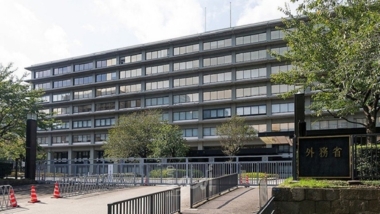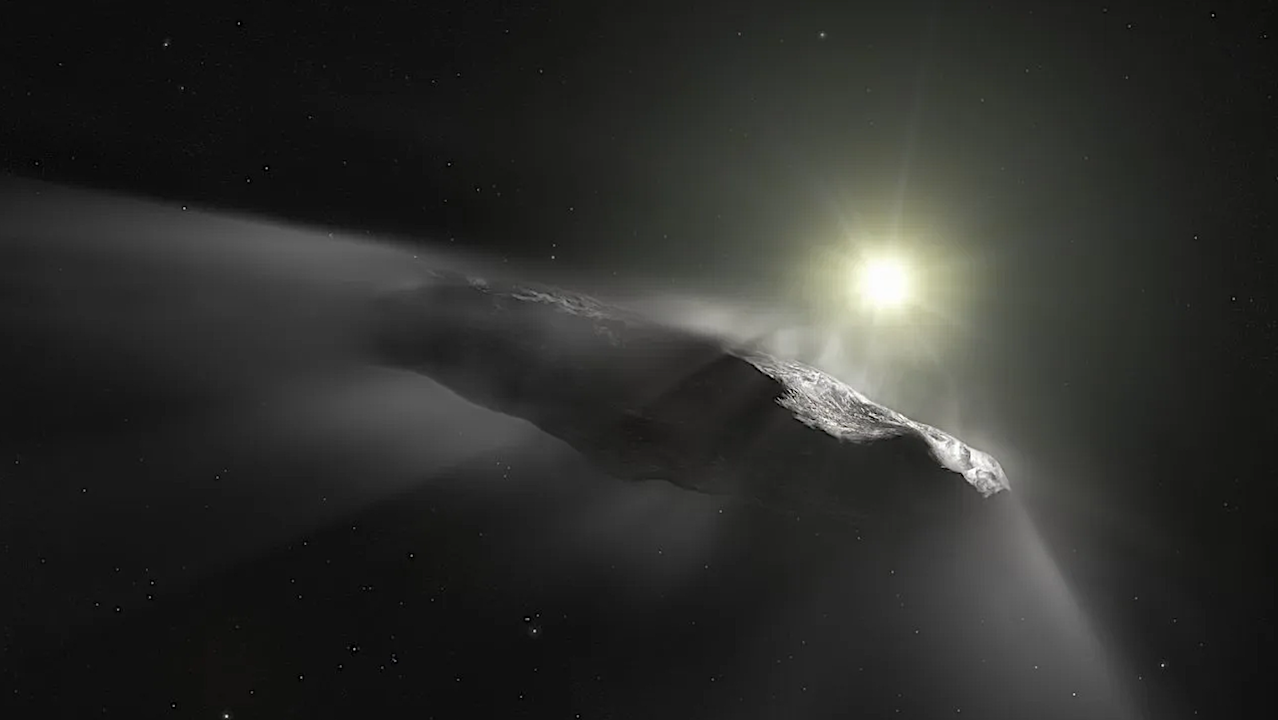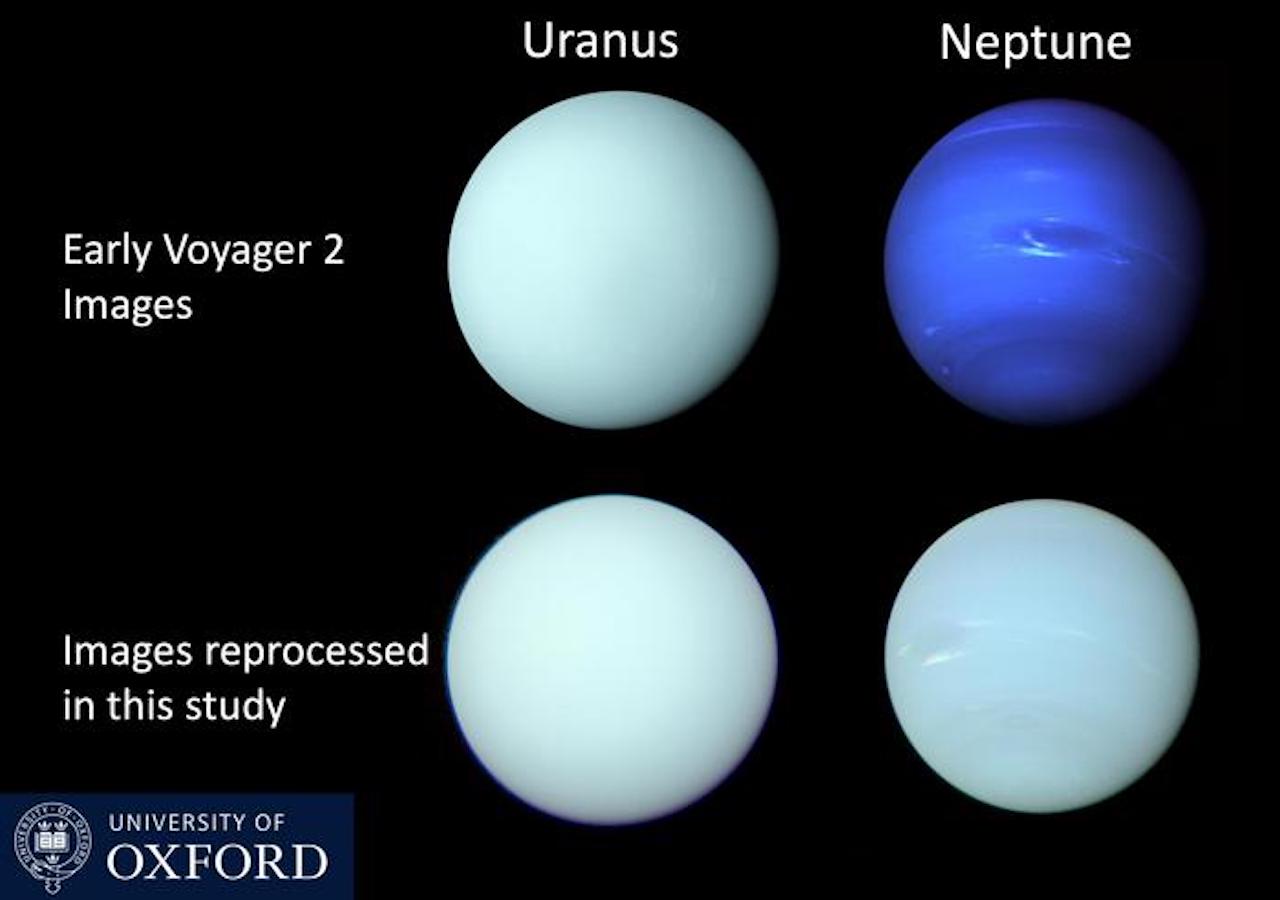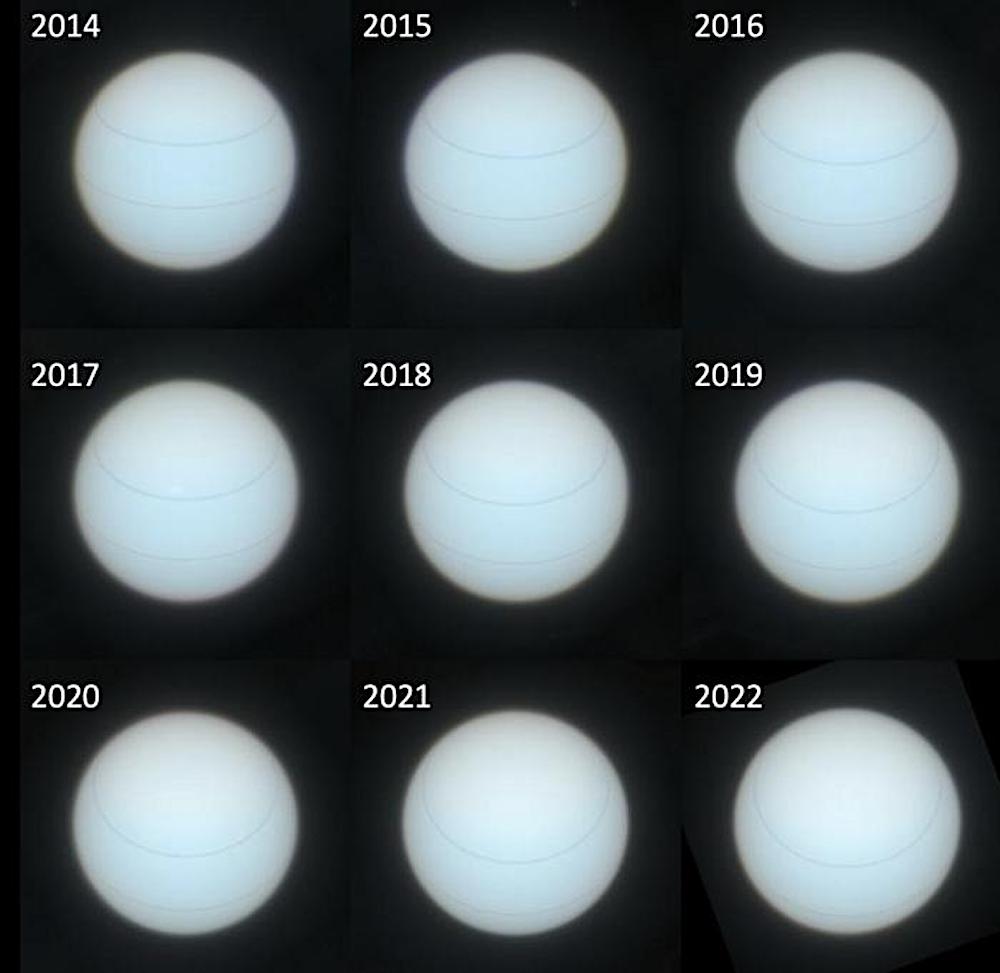Pro-Palestine demonstrations held across the island of Ireland

People take part in a pro-Palestine march and rally at Belfast City Hall (David Young/PA)
By David Young, PA
Thousands of people demanded an immediate ceasefire in Gaza as they took part in pro-Palestine rallies in various locations across the island of Ireland.
Belfast and Cork saw two of the largest protests on Saturday.
In Dublin, a smaller demonstration outside RTE’s headquarters saw 108 pairs of shoes laid out in a display activists said was to signify the number of journalists killed since the conflict began in October.
The rally at Belfast City Hall came after supporters of the Palestinian cause marched through the city centre on Saturday afternoon.
Protesters carrying Palestine flags and placards criticising the Israeli regime were among the large crowd that gathered outside the gates of the landmark building to hear a series of speeches.
108 pairs of shoes for each journalist killed in Gaza are laid out as Mother’s Against Genocide protest outside RTE in Dublin (Niall Carson/PA)
The addresses were interspersed with chants and songs voicing support for the Palestinian people and demanding a ceasefire in Gaza.
Among the speakers was Mark McTaggart, who is northern secretary of the INTO teaching union and also spokesman for the Trade Union Friends of Palestine group.
He reflected on the numbers of students and teachers who have been killed in Gaza and the West Bank.
“We look at what happened in our country during the time when there was unrest – education was the last bastion of hope for most people, it was the schools and the schoolteachers from across the north who kept children safe and schools were seen as places of safety,” he said.
“Those chances and those life chances are being taken away from young people across in Palestine.”
Mr McTaggart also encouraged people to actively boycott Israeli goods and companies.
People take part in a pro-Palestine march and rally at Belfast City Hall (David Young/PA)
In Cork, hundreds attended a demonstration organised by The Cork Palestine Solidarity Campaign.
Similar demonstrations have taken place in the city every weekend since the conflict erupted.
The protest at RTE HQ in Donnybrook in Dublin was organised by the group Mothers Against Genocide.
One of those taking part was sustainable development scientist Naomi Sheehan.
She said Ireland’s national broadcaster should be referring to Israel’s actions in Gaza as “genocide”.
“It’s hard to even speak about this because it is so emotional, this is like witnessing the worst human rights atrocities of our times,” she said.
“It’s a silent genocide and we are hearing a deafening silence in terms of assigning appropriate accountability to the forces who are enabling this genocide.”
Cities on the island of Ireland have also witnessed pro-Israeli demonstrations since the conflict began in October.
Saturday’s pro-Palestinian protests were staged after Tanaiste Micheal Martin warned that a widening of the conflict in the Middle East would have devastating consequences for the world.
Mr Martin’s comments came as Hezbollah in Lebanon claimed it fired dozens of rockets at Israeli observations posts after it blamed Israel for a strike on Beirut that killed a senior Hamas official during the week.
The Tanaiste also rejected suggestions coming from some Israeli ministers that large numbers of Palestinians should be relocated out of Gaza.
Mr Martin further expressed concern about the situation in the Red Sea where commercial ships have been attacked by Houthi rebels from Yemen.
The Irish minister for foreign affairs said the need for an immediate humanitarian ceasefire in Gaza was “more urgent than ever”.
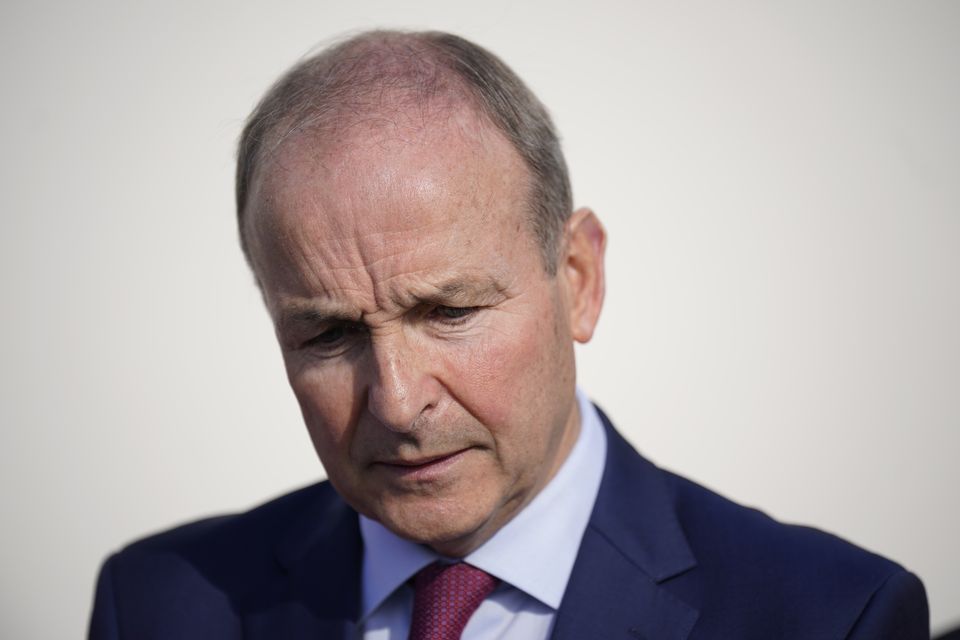
Tanaist Micheal Martin reiterated his call for a ceasefire in Gaza (Niall Carson/PA)
He also stressed the urgency of the immediate and unconditional release of all hostages held in Gaza and “full, safe and unhindered humanitarian access” to the enclave.
“Events across the region in recent days are also a stark reminder of the potential for further escalation,” he said.
“A widening of this conflict would have devastating consequences for the region and for the world.
“The international community simply cannot allow further civilian suffering and deaths. I urge all parties in the region to exercise restraint and avoid escalation.”
The Tanaiste added: “Attacks on shipping in the Red Sea by the Houthis in Yemen are not only putting the lives of the crews in danger but are having an increasingly serious impact on global trade, with all the consequences that has for the lives and livelihoods of communities across the globe.
“As always, it is the poorest and most vulnerable communities – in the Middle East, Africa and globally – that are the most severely affected.
“This trajectory must be reversed. The international community, including parties in the region, must, in the first instance, redouble efforts to end the conflict in Gaza.
“But our ambition should not be limited to de-escalation. We must take concrete steps to achieve long-term peace, stability and security for Palestinians and Israelis and for the region as a whole. This can only be done through a sustained and serious commitment to a two-state solution; not as an oft-repeated shibboleth but as a concrete reality.
“In that context, the recent comments by Israeli government ministers calling for the resettlement of Palestinians outside of Gaza are utterly unacceptable and inflammatory. Gaza is Palestinian land and is an integral part of a future state of Palestine.”
Pro-Palestinian demonstrators in UK intensify calls for immediate Gaza cease-fire
As Israel's war on Gaza extends into its 92nd day, local communities once again mobilizing, taking to streets to protest against Israel
Aysu Bicer and Cuneyt Karadag |06.01.2024

LONDON / BERLIN
As Israel's war on Gaza extends into its 92nd day, pro-Palestinian demonstrators in the UK have intensified their calls for an immediate and permanent cease-fire in the blockaded strip.
Despite the passing days, the fervor of the protesters shows no signs of waning. Local communities are once again mobilizing, taking to the streets to amplify their collective demand for an end to the conflict and a lasting resolution.
The widespread demonstrations are aimed at urging a cease-fire in Gaza, with participants converging in various cities, including Birmingham, Bristol, Brighton, Canterbury, Oxford, and Hastings.
Amid diverse locations, local London marches are scheduled in areas such as Camden, Hackney, Harrow, and Ealing.
Notably, the Camden protest featured a rally outside the office of Labour leader Keir Starmer.
Campaigners have criticized Starmer for his perceived failure to advocate for a cease-fire in the Gaza Strip despite the growing death toll.
Protesters chanted anti-Israel slogans and carried Palestinian flags and signs, with some reading "Stop bombing Gaza," "You should be ashamed," "From river to sea Palestine will be free," "Freedom for Palestine," "End Genocide," and "Cease-fire now."
"With Israel’s catastrophic onslaught ongoing, we must continue to take action to demand a cease-fire now, and an end to British complicity in Israel’s apartheid rule over the Palestinian people," the Palestine Solidarity Campaign said in a statement.
Addressing the protesters in Camden, Sabby Sagall, the president of the Camden Palestine Solidarity Campaign, said Israel has intensified its attacks on Gaza.
Pointing out Israel's history of ethnic cleansing since 1947, Sagall praised the International Criminal Court's application against Israel, submitted by South Africa, and described it as the most positive step taken during this process.
Sagall, expressing support for the Palestinian people as a Jew, said Israel has been terrorizing Palestinians for 75 years.
'British government diplomatically covering up genocide'
In his speech, Andrew Murray, deputy president of the Stop the War Coalition, emphasized the need for an end to political support in the UK for Israeli "genocide" in Gaza.
"The British and the American governments are ignoring the genocide. Our government is arming the genocide, it is politically supporting and diplomatically covering up genocide," he said.
"No movement is more important than the one we have built in Britain and our government's political support of this genocide must be broken," he added.
"Israel has been doing genocide and we can see it in the dead babies in their incubators. We can see it in the attacks that is making Gaza unlivable in the foreseeable future," he said.
A retired doctor Jonathan Flaxman, who is also Jewish, gave some information about what has happened to the health sector in Gaza and Palestine.
"There's no functioning health service in northern Gaza. Twenty-three out of 36 hospitals have been destroyed. And by destroying the hospitals, people who are injured, who couldn't be saved, will die slow, painful death. We know that it's part of the ethnic cleansing," he added.
Flaxman said hospitals are deliberately attacked under the pretext of targeting Hamas leaders, leading to the intentional targeting of health care workers, with over 300 of them killed.
Meanwhile, a group calling themselves the Organise Corbyn Inspired Socialist Alliance has started working to field an independent candidate against Starmer in the next election to oust the leader of the Labour Party.
"I am outraged that Keir Starmer hasn't called for a cease-fire. There are beautiful children in Gaza right now being murdered, being slaughtered, being traumatized. And Starmer hasn't voted for a cease-fire and we are outraged and we are campaigning to unseat him in his constituency," an alliance volunteer told Anadolu.
She said the politicians shouldn't take the people for granted, saying: "They need to listen to us, and millions of us want a cease-fire in Gaza."
She added that 26,000 votes are needed to elect a new member of parliament to replace Starmer.
Phil Davidson, one of the campaign volunteers, mentioned being prevented from voting in internal party elections as a former Labour Party member.
"I dedicate my time to make sure that Starmer was not in parliament. I see him live threat to democracy and democratic values," he said, adding that there must be an MP who will put the good of humanity first.
"It's not about socialism. It's not about conservatives. It's not about Islam or Christianity. It's about doing the right thing, looking after the weakest helping people when they need it," he added.
Pro-Palestine demonstration held in Berlin
Also, a demonstration in solidarity with Palestine was held in Germany’s capital Berlin on Saturday.
Nearly 1,500 protesters gathered at Mehringplatz Square and marched to Potsdamer Platz in the center of Berlin, conveying messages of support to Palestine as well as protesting Israel's attacks on Gaza.
Protesters chanted slogans such as "Israel is a terror state," "Killing children is a crime," "Why are you silent, Scholz?" "Freedom for Palestine," "Stop the genocide in Gaza," "Germany finances, Israel bombs," and "Stop the war."
Carrying Palestinian flags, protesters held banners with messages such as "Stop killing innocent people," "Chancellor Scholz, Foreign Minister Baerbock, when will you have enough blood?" "German politicians are silent, deaf, and blind to Palestine," "End the occupation in Gaza," and "You cannot build sacred grounds on the mass graves of children."
Pro-Palestine London protests turn violent, protesters clash with police
ByMallika Soni
Jan 06, 2024
Pro-Palestine protests in London: Scuffles broke out as officers advanced towards the protest leader who was giving a speech.
Protesters at a demonstration against Israel's war in Gaza clashed with police in London as Metropolitan Police officers attempted to break up the march while hundreds of people gathered at St James’s Park. Scuffles broke out as officers advanced towards the protest leader who was giving a speech. Police also prevented demonstrators crossing Westminster Bridge.

Some protesters were heard chanting “shame on you” and “who do you serve, who do you protect?” while others were seen waving Palestinian flags and holding placards condemning Israel’s war in Gaza.
The Free Palestine Coalition (FPC) made up of “grassroots organisations in London, including Sisters Uncut, Black Lives Matter UK, London for a Free Palestine, and the Palestinian Youth Movement” called for the protest and said that they will be “blockading a well-known location in London”
“The FPC has chosen this date, in advance of Parliament returning, to send a strong signal to the UK Government that Palestine is a political priority and that there can be no business as usual,” it said after which the police said that a large number of officers will be in central London “to minimise disruption and deal with any offences”.
“Various protest groups, including Sisters Uncut and Black Lives Matter, are planning to hold a protest in central London today. Officers have attempted to speak with the organisers, however they have not shared any information with us about their proposed route. This has an impact on how we plan our policing response and means more officers have to be deployed to central London to ensure we can respond quickly," the police said.
Protesters clash with London police at Westminster bridge
Pro-Palestinian protesters took to the streets demanding an immediate Ceasefire in Gaza. Clashes occurred between protestors and the Metropolitan police who stated that the protests were not authorised, they were, however, allowed at a restricted area until 3 pm. The Metropolitan statement said: ‘We have a duty to allow people to take part in legal protest. When there could be serious disruption, we impose conditions to prevent this.’ Protesters demanded an end to the 3-month ongoing genocide in Gaza and an immediate ceasefire.
January 6, 2024
Pro-Palestinian Protesters Block Bridge Outside UK Parliament
January 06, 2024
Reuters
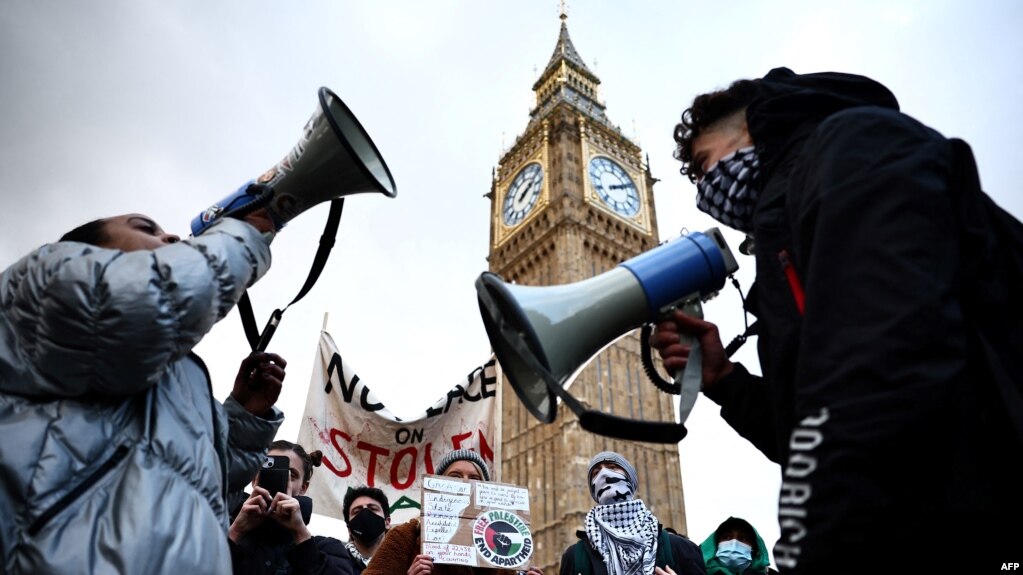
LONDON —
Pro-Palestinian protesters blocked roads outside the British parliament in London on Saturday, demanding an immediate cease-fire in the Israel-Hamas war and clashing with police who prevented them from marching across Westminster Bridge.
London, like other Western cities, has seen regular and sometimes large demonstrations calling for Israel to halt the bombardment of Gaza triggered by a surprise October 7 attack by Hamas militants that Israeli officials say killed more than 1,200 people.
The Hamas-controlled Gaza Health Ministry says 22,722 people have been killed in Israel's bombardment.
Videos posted on social media showed police blocking protesters' access to the bridge, and a Reuters reporter said there had been several small scuffles. Unable to fully access the bridge, where they had planned to unfurl banners, protesters instead occupied the surrounding roads.
Police said that they had imposed a legal order limiting the location of the protests and that by 3 p.m. people had begun to disperse. Those who refused to comply with an order to leave could be arrested, police said.
Saturday's action was smaller than previous mass marches but came two days before the British parliament returns to work after its Christmas break. The protest was designed to push politicians to adopt a harder stance toward Israel.
So far, Britain has stopped short of calling for an immediate cease-fire, with foreign minister David Cameron arguing that any such agreement could be unsustainable and may worsen violence without a plan for longer term peace.
Most previous protests in London have been coordinated with police and remained largely peaceful, but police said the organizers of Saturday's protests had refused to share details of their plans.
Pro-Palestinian protesters stage sit in at Westminster Bridge
Pro-Palestine protesters block bridge outside UK parliament
Demonstrators gathered on the streets of central London, demanding an immediate ceasefire in Israel’s war on Gaza.

Published On 6 Jan 20246 Jan 2024
Hundreds of pro-Palestine demonstrators blocked access to a bridge near the British parliament on Saturday, calling for a ceasefire in Gaza in an act of civil disobedience.
London, like other Western cities, has seen regular and sometimes large demonstrations calling for an end to Israel’s bombardment of the besieged strip.
Police clashed with the protesters, who occupied surrounding roads after they were prevented from marching across Westminster Bridge, where they had planned to unfurl banners.
Police said they had imposed a legal order limiting the location of the protests and that by 3pm (15:00 GMT) people had begun to disperse. Those who refused to comply with an order to leave could be arrested, police said.
Saturday’s action, the first major demonstration of the new year, was smaller than previous mass marches but comes two days before the UK Parliament returns to work after its Christmas break.
The protest was designed to push politicians to adopt a harder stance towards Israel in its war on Gaza, which has killed more than 22,700 Palestinians in three months.
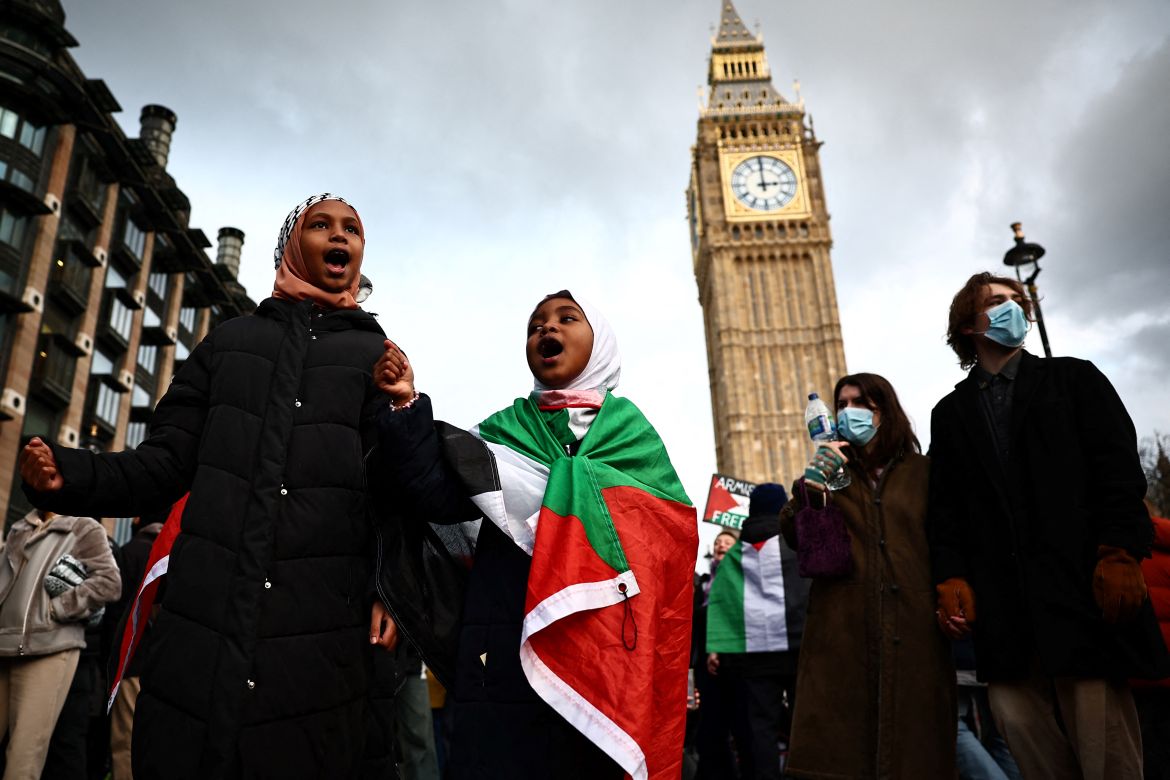



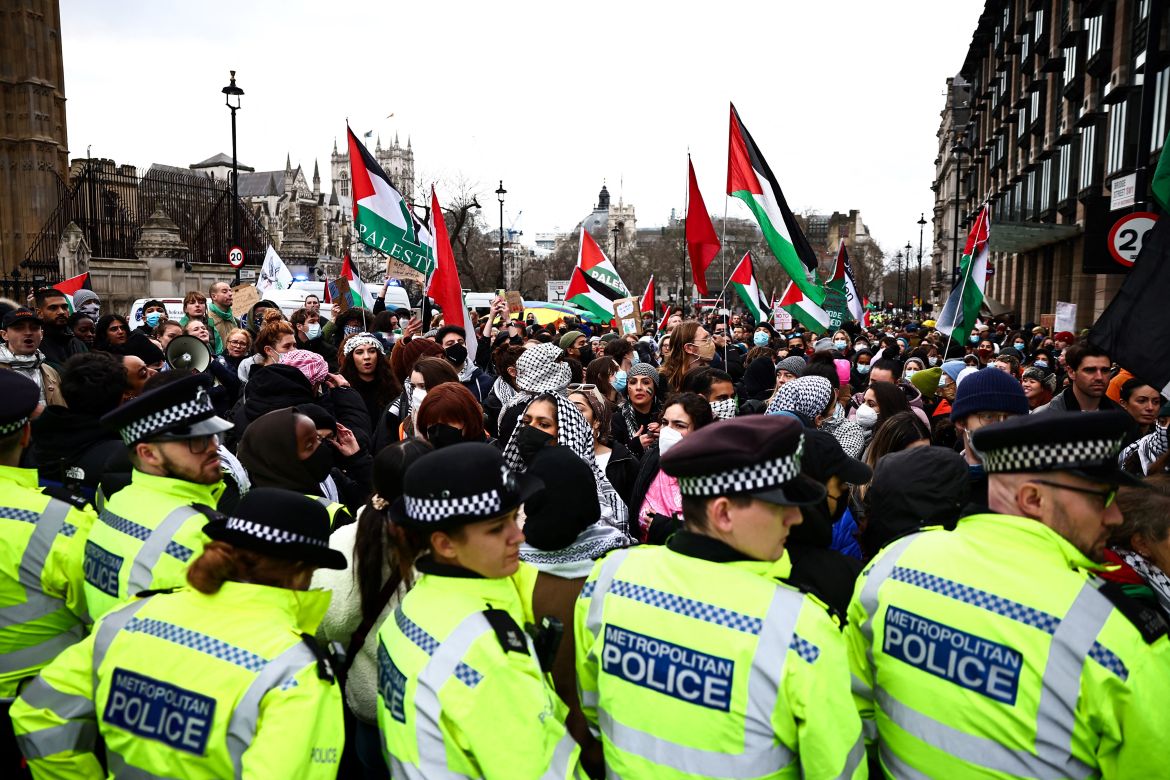

Advertisement








